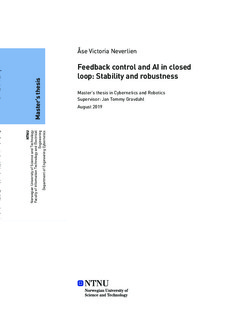| dc.contributor.advisor | Jan Tommy Gravdahl, Signe Moe | |
| dc.contributor.author | Åse Victoria Neverlien | |
| dc.date.accessioned | 2019-10-31T15:15:17Z | |
| dc.date.issued | 2019 | |
| dc.identifier | no.ntnu:inspera:35771502:33795552 | |
| dc.identifier.uri | http://hdl.handle.net/11250/2625766 | |
| dc.description.abstract | Tradisjonelt ville man håndtert surge i kompressorsystemer ved å operere langt fra «the surge line». Ved å gjøre dette vil systemet være stabilt i åpen sløyfe og man unngår dermed at surge oppstår. Selv om dette vil sikre integriteten til systemet, vil det også begrense operasjonsområdet til kompressoren. Hvis surge skulle oppstå vil det redusere ytelsen til kompressoren, eller i verste fall resultere i at den blir ødelagt.
Målet for denne mastergradsoppgaven har vært å utvikle en anti-surge kontroller for Moore-Greitzer kompressoren kombinert med en CCV, med hensikt å utvide operasjonsområdet. Anti-surge kontrolleren baserer seg på en kombinasjon av Lyapunov kontroll teori og neurale nettverk. Lyapunov kontroll teori har vist seg å være nyttig for både å finne og lage stabile attraksjonsområder for dynamiske systemer i lukket sløyfe, mens neurale nettverk er gode på å lære seg ulineære systemer.
I denne avhandlingen har to kontroll-lover for Moore-Greitzer kompressoren, som baserer seg på en neural nettverk Lyapunov funksjon, blitt utviklet. Den første kontroll-loven resulterte i et globalt asymptotisk stabilt likevektspunkt. Den andre kontroll-loven har fokus på minimering av trykktapet over CCVen og resulterte i et lokalt asymptotisk stabilt likevektspunkt. En treningsalgoritme som iterativt bygger et estimat av det faktiske attraksjonsområdet er benyttet for å visualisere prestasjonen til Lyapunov funksjonen. Lyapunov funksjonen basert på neurale nettverk dekket tilnærmet 81% av det estimerte attraksjonsområdet. Resultatet ble sammenlignet med en tradisjonell Lyapunov funksjon. | |
| dc.description.abstract | Historically, one would handle surge in compressor systems by operating far from the surge line, and by doing so, simply avoiding the risk of surge. This will ensure both the mechanical integrity and the safety of the machines, but it will also limit the range of mass flow for which the compressor can be used. As surge can cause a reduction in performance, or even damage the compressor, it is of major interest to be able to predict unstable operation of the compressor in order to expand the range of mass flow and thus expand the operating range of the compressor.
In this thesis, an anti-surge controller is proposed using a close-coupled valve(CCV) and a state-of-the-art neural network(NN) Lyapunov function candidate for the Moore-Greitzer compressor. A CCV in combination with the Moore-Greitzer com- pressor can stabilize the system by modifying the characteristics of the compressor. Lyapunov control theory has shown useful in order to determine and construct a safe region for closed-loop dynamical systems. The objective of this thesis has been to gain an overview of the state-of-the-art regarding stability and robustness in nonlin- ear dynamical systems in order to maximize the safe level set that can be used as a safety certificate for a given nonlinear, closed-loop dynamical compressor system. To the best of the authors’ knowledge, an anti-surge controller for the Moore-Greitzer compressor has never been implemented with the combination of Lyapunov control theory and NNs before.
Two control laws for the Moore-Greitzer compressor in series with a CCV is created using a NN Lyapunov function. The first control law resulted in a global asymp- totically stable equilibrium beyond the original surge line. The second control law focused on minimization of the pressure drop across the CCV, and the equilibrium point was shown to be locally asymptotically stable. A training algorithm that iter- atively ”grows” an estimate of the largest safe region in the state space was used to show how well the different Lyapunov functions scored. The NN Lyapunov function covered approximately 81% of the estimated region of attraction. These results were compared to a traditional Lyapunov function candidate. | |
| dc.language | eng | |
| dc.publisher | NTNU | |
| dc.title | Feedback control and AI in closed loop: Stability and robustness | |
| dc.type | Master thesis | |
